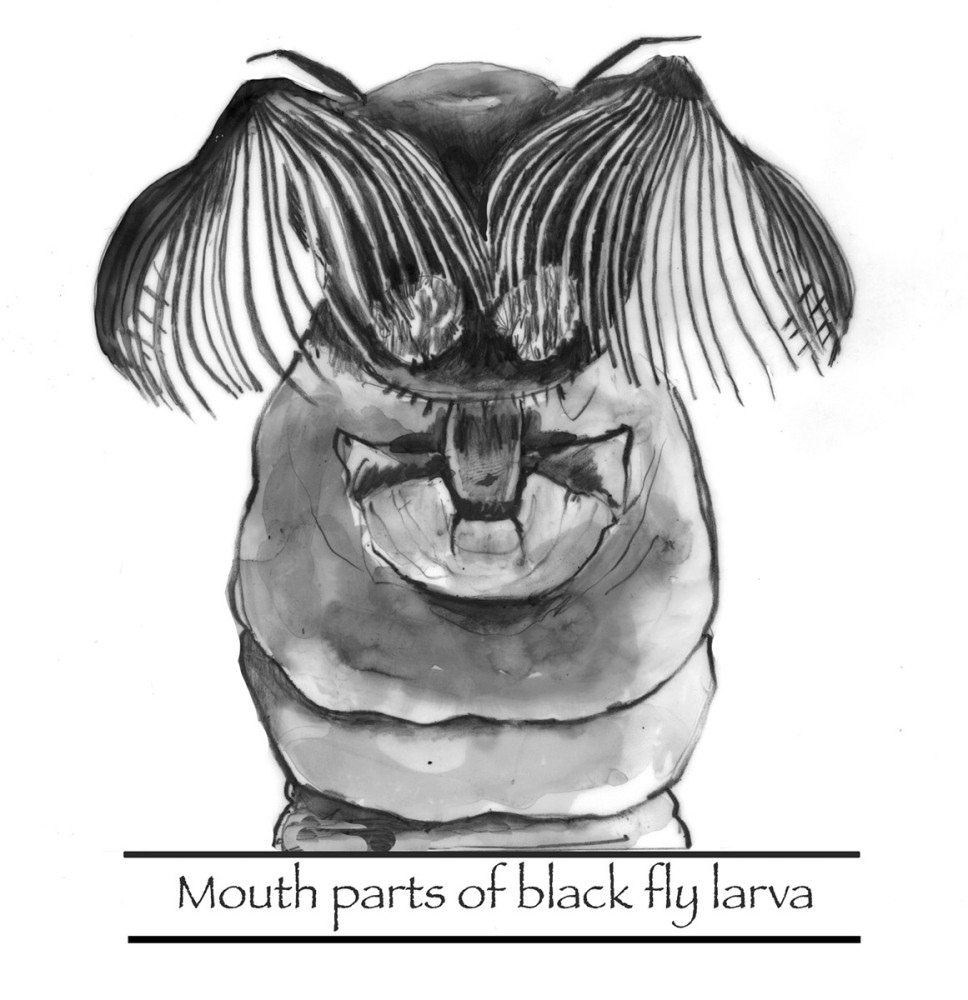
I was in southern Connecticut a few weeks back to pick my son up from college. While he took his last exam, I took myself up a local hiking trail. Connecticut black flies are as bad as their Vermont cousins, and I brushed several of the little beasts out from under my hairline. It can be hard to think of these biting flies with anything but disdain, but they do serve important ecological functions. And in at least one case, they also solved a murder.
Black fly larvae are little, black, and shaped like bowling pins. They live in rivers and streams, and on their back end they have a circle of hooks that keeps them from being washed downstream. This is essential for survival; drifting organisms can rapidly become fish food.
Each larva attaches a clump of silk to a rock and then uses its hooks to get a firm grip on the silk. This leaves the other appendages free to collect food. “Appendages” is a loose term; like other true flies (order Diptera), black fly larvae lack legs entirely. But where there’s a need, nature provides a solution, and in the case of black flies, their mouth parts have evolved into an elaborate pair of fans.
The fans open up like many-fingered hands with countless hairs attached to each finger. The open fans reach upwards, grabbing particles that drift by and effectively filtering the water for morsels of food too obscure, too microscopically tiny, for the average human, or fish, to notice. When my Saint Michael's College students first find one in a preserved sample, I encourage them to gently squeeze the larva’s head with forceps. Long dead specimens will still open and close their fans right there, filtering the alcohol under the microscope. And in rivers and streams, the water is cleaner from all of this filtering.
Black flies fatten under water and emerge as little flies that crawl on us in search of blood. For many of us, the flies are a mere annoyance; for some they elicit allergic reactions. Many of the fattened larvae and emerging flies become fish food. The pupal stage, between larva and fly, occurs in silk structures that are fastened firmly to hard substrates and would be challenging for the average fish to dislodge. And it is the pupal stage that brings us back to the murder case.
In June 1989, scuba divers discovered an upside down car in a deep hole in the Muskegon riverbed in Michigan. Inside lay the remains of a woman, well preserved by the cold river waters. Determining time of death proved difficult, but all evidence suggested foul play, and her husband quickly became the prime suspect. Among the evidence collected from the vehicle were three insect varieties, but it was the black flies on the car’s windshield that turned out to be the key witnesses.
In fact the black flies were long gone, leaving only their empty silk cases to suggest they had ever been there. Yet these small silken structures were all that was needed to break the case. With underwater crime scenes, detectives are tasked with determining the PMSI, or postmortem submersion interval. With a little knowledge of aquatic insect life histories, PMSI can often be determined, or at least narrowed down.
And so, scrapings from the car windshield and elsewhere were sent to Dr. Richard Merritt at Michigan State University, one of the world’s foremost black fly experts. The timeline of the particular case hinged upon a few facts: the husband claimed that his wife had left the house on a foggy September night following an argument. He also claimed to have heard from friends who had been in contact with her during the subsequent winter and spring. The black flies offered a different opinion.
By examining a few scraps of silk secreted and assembled by black flies on the windshield of a car, Dr. Merritt concluded that the car, discovered in June, had been submersed at least since fall of the previous year. This particular black fly did not build cocoons during the cold of the Michigan winter, or spring; only during fall.
And so these obscure, and sometimes annoying little flies, were used to refute the husband’s story of his wife whiling away the hours through winter and spring. Black flies, along with other evidence, sent him to jail for a 20-year sentence.
And although it is unlikely that the black flies swarming around your head or mine will solve any crimes, perhaps we can take solace in them cleaning the water and providing the link between microscopic food particles and the fish we love to catch.


Discussion *